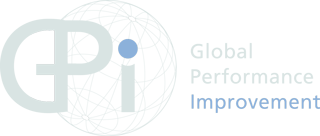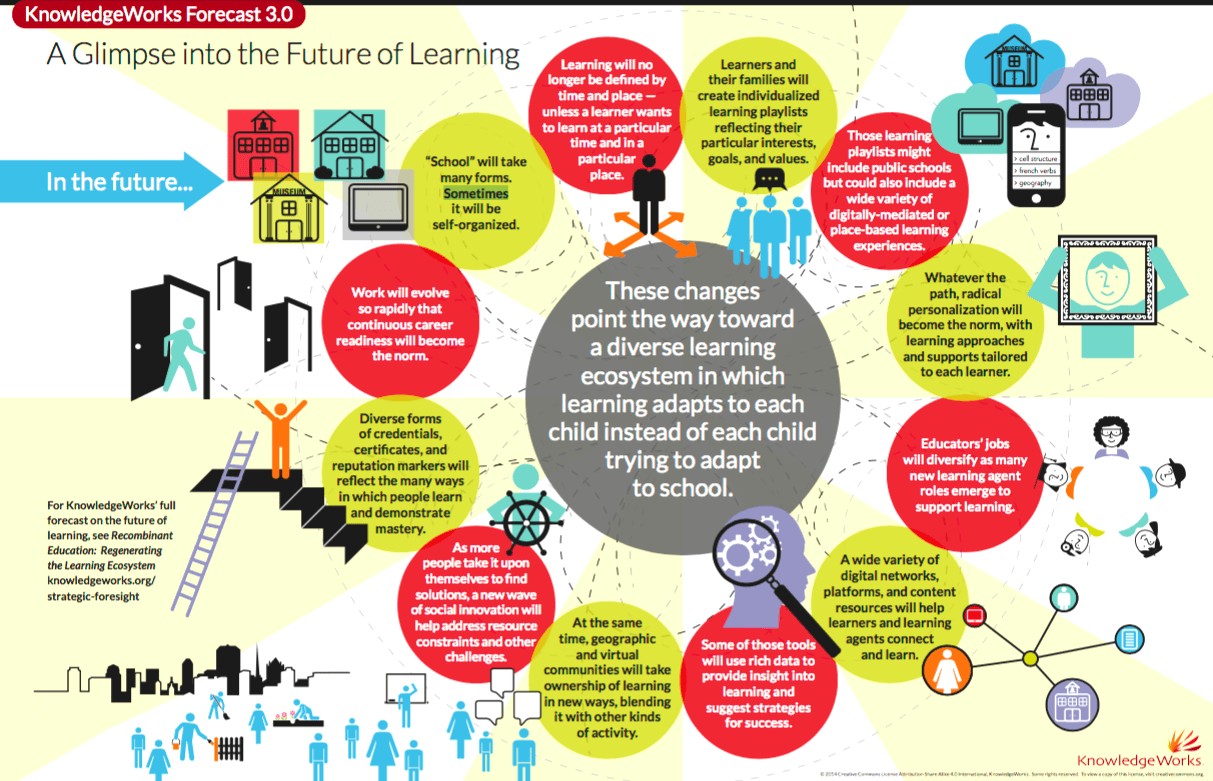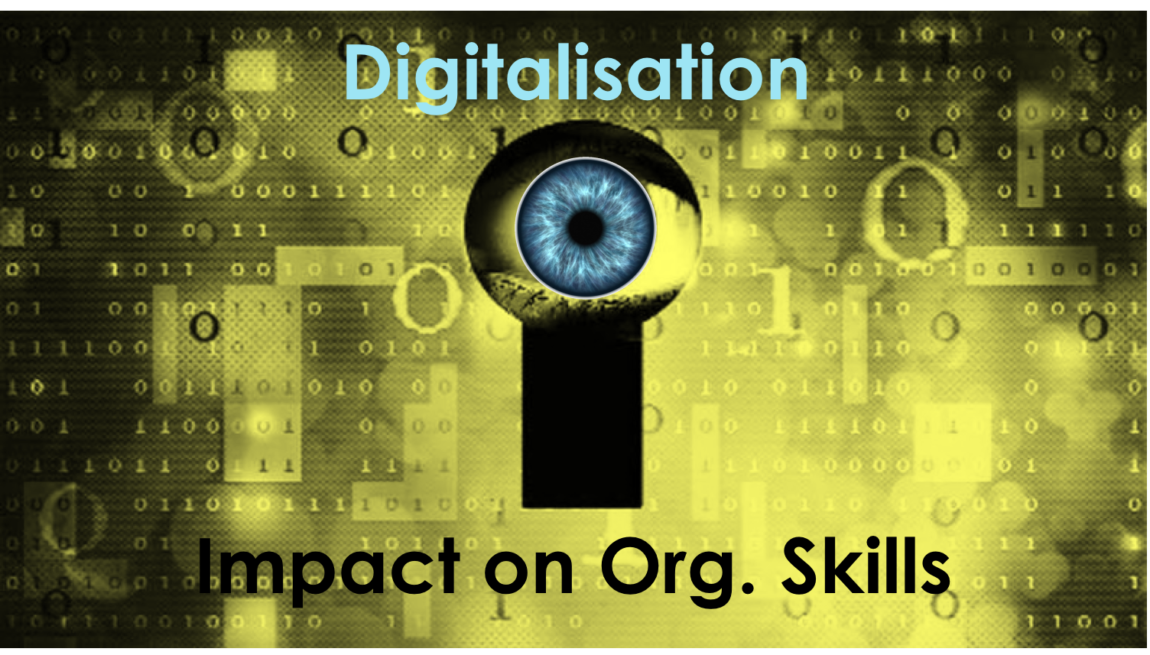
Digitalisation 2.6 – Impact on Organisational Skills
Intro
This article is part of a series looking at how digitalisation affects an organisation as a whole. We have previously clarified the difference between internal and external digitalisation and why it is essential to get ‘your house in order first’.
The series provides a practical logic and explores how all aspects of a business are impacted and 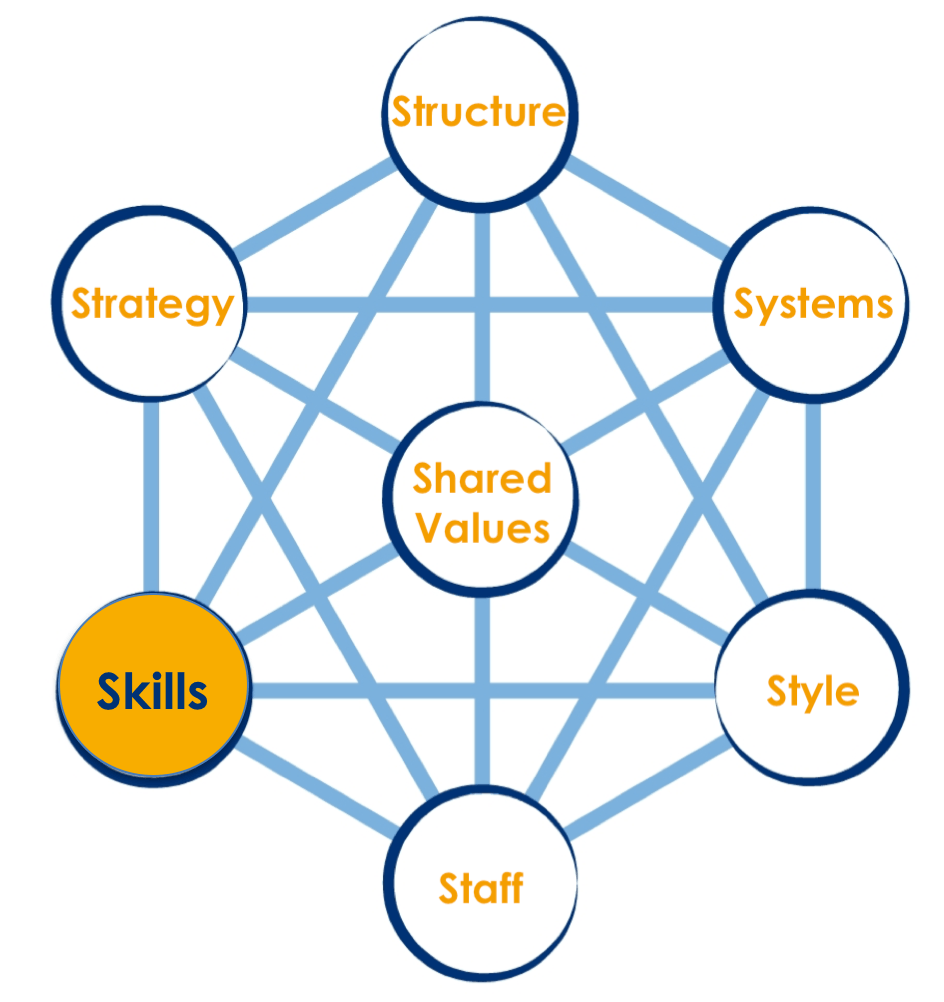 interdependent. We use the 7S model as a framework, a concept which considers all essential parts of a business. We now have articles on:
interdependent. We use the 7S model as a framework, a concept which considers all essential parts of a business. We now have articles on:
- Strategy (e.g. strategy development, communication, execution)
- Structure (e.g. organisational set-up, management structure, roles & responsibilities)
- Systems (e.g. role of IT, process management, measurability)
- Style (e.g. leadership and communication style, decision-making)
- Staff (e.g. hiring, people development).
The model is based on the premise that, for an organisation to perform well, 7 elements need to be aligned and mutually reinforcing – the business example in this video demonstrates the interdependencies. The model can be used to identify what needs to be (re)aligned or how to maintain alignment (and performance) during times of change. It effectively illustrates the organisational impact when managing accelerated change like digitalisation.
Today, we take a closer look at how digitalisation can transform an organisation and its skills set.
Digitalisation & organisational capabilities (skills)
Organisational skills refer to competencies of the whole organisation. This is not the knowledge and competencies of individuals but joint abilities, e.g. the capacity to solve problems as an organisation or to learn new habits as a group. It is the ability to achieve an organisation’s strategic objectives and it reflects in its performance. In short, it is about how the entire organisation responds to outside market and client forces.
Similarly to Style, i.e. a company’s culture, Skills are considered a ‘soft’ element. They are more difficult to define or identify, and management would usually influence them indirectly.
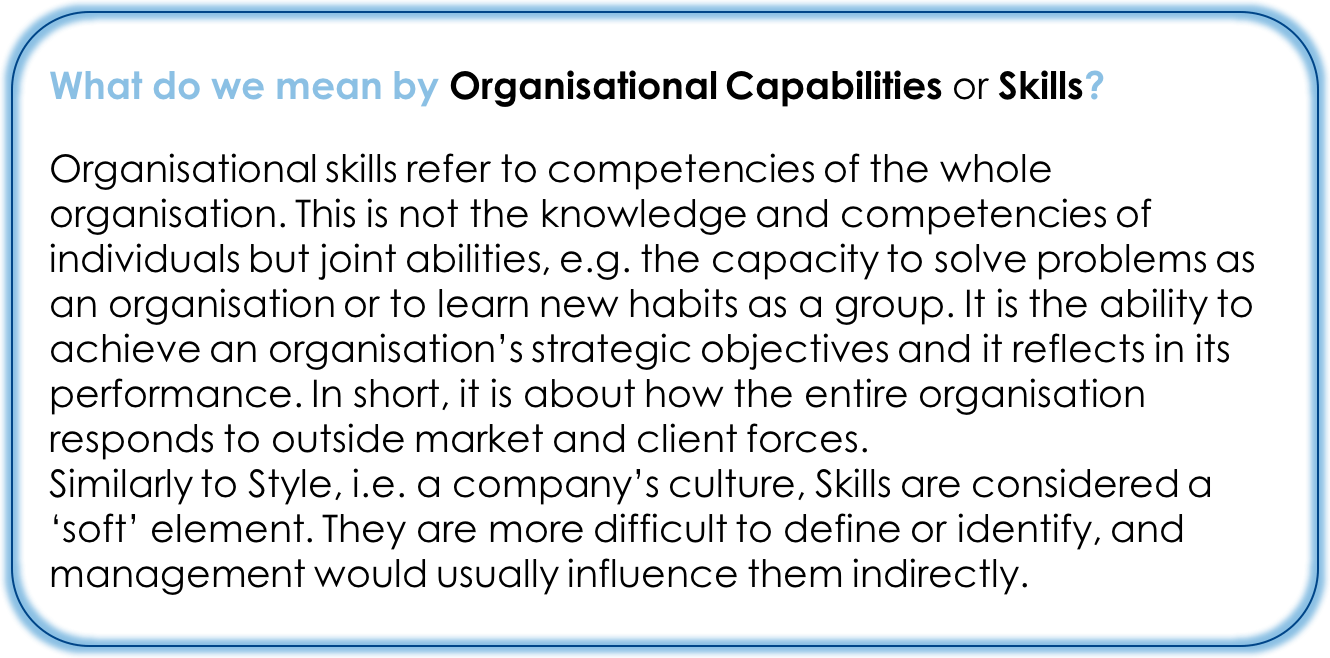
Why should we bother?
Today knowledge has power. It controls access to opportunity and advancement.
Peter Drucker
The first time I came across the power of knowledge was in one of my corporate jobs. IT introduced us to the findings of an internal study by Siemens, identifying they would be able to improve their performance by over 30% if only they managed to provide employees with the right information at the right time in the right place.
As we all know, the markets and systems in which businesses operate are becoming more volatile, uncertain, complex and ambiguous. I doubt that more than 5 of the current Fortune 500 will still be in existence in 30 years’ time. Companies need to be responsive and act as a unit.
With this in mind, it is more important than ever for key players to work on their organisations as it is to work in them. I have always been fascinated by the concept of larger entities as living organisms but I also understand it is too abstract for many people.
This article looks at Knowledge Management [KM] and Learning Organisation as related and mutually reinforcing aspects, and provides insight into how people in companies can work ON their organisations (see following visual). Digital tech is the key enabler to future-proof your company but is your organisation digital-ready?
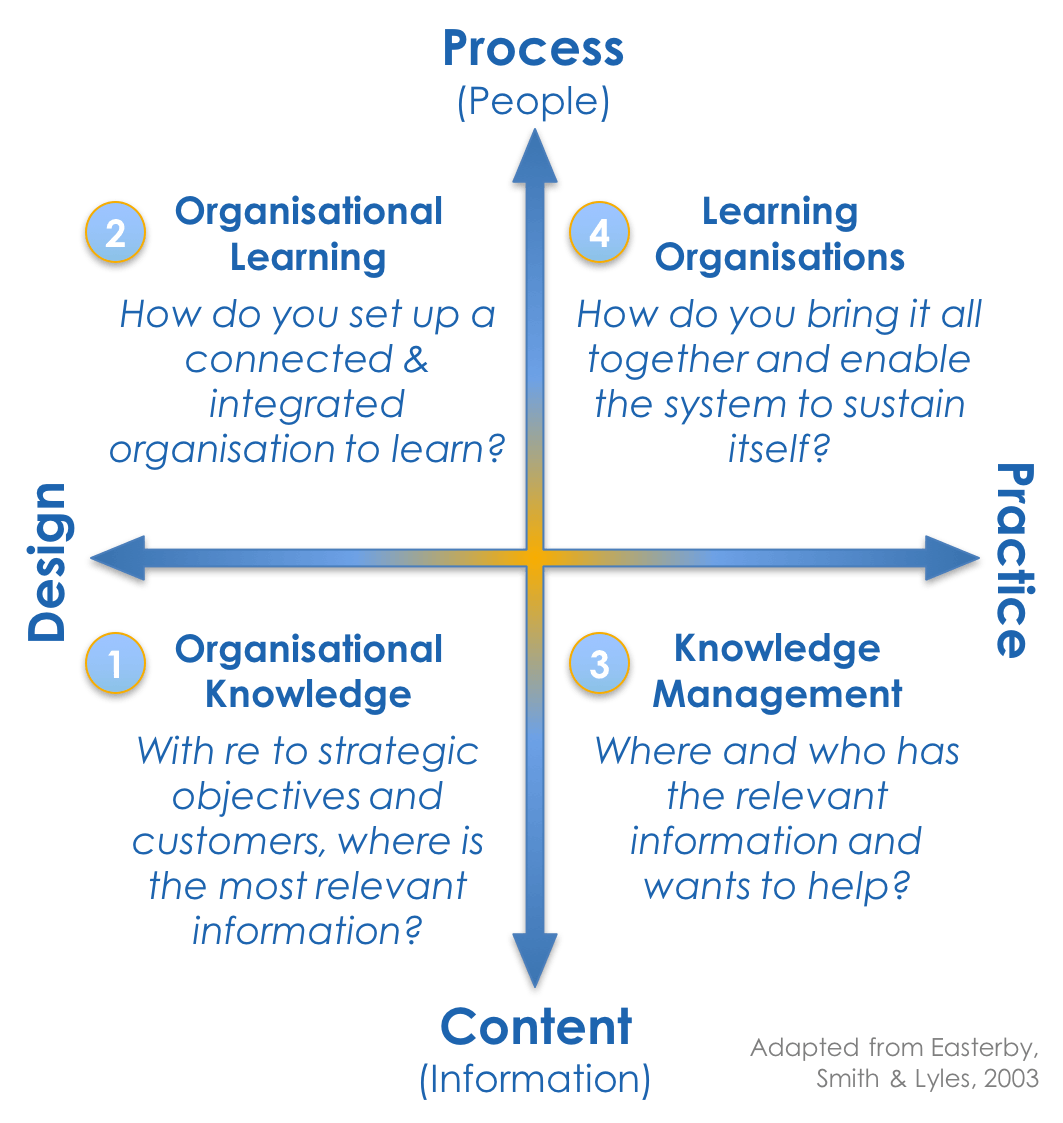
The way a company differentiates itself from competitors and attracts customers is key, and digital technologies will only make this more so. This is directly related to the core strengths of an organisation. If you want to move from a structured organisation with siloed departments, focussed on efficiency, experts and specialists to an agile company informed by market developments and quickly reacting to customer opportunities, then you need people.
In the words of Frank Leistner, Chief Knowledge Officer at SAS: “culture and people comprise 70% of successful digitalisation; process is 20% and technology 10%. So people are key. Digital tech provides great advantages but is merely an enabler.
Getting started
Start with your customers and strategy
This is not an easy endeavour, as outlined in the article on digitalisation and strategy. However, it is vital to slowly align your current strategy and digital strategy.
When starting, everything should be called an initiative rather than a project as your attempts will evolve but never conclude. You need to get used to modern working styles and be pragmatic because digital strategy is a bit like big data and you can easily get carried away. The main objectives are ‘customer intimacy’ and improving the overall performance.
All parties involved need to co-operate: IT people providing technical solutions, records managers providing guidance on appraisal and retention of digital material and on documenting digital sources, auditors and controllers pointing out critical issues for successful policy implementation. Clarify the nature and pace of work. Fostering KM among scientific, technical personnel such as engineers and researchers would demand a different tactic than you’d use with customer-service or sales teams. Successful collaboration is best initiated on commonalities.

Let’s get practical and follow the logical sequence of the 4 sections in the graph. 1st identify the dots in your current organisational knowledge landscape. 2nd look at customer needs and start connecting the dots. The resulting map will be part of your master plan. 3rd bring information to life by engaging with people to share, contribute and apply. Last but not least (4), identify more knowledge dots, connect them and initiate a learning organisation.
Organisational knowledge

You need to identify the most relevant information to ensure longer term strategic successes. This means understanding how information is created, by whom and how to capture and transform it.
Organisations must adapt KM to retain and transfer knowledge. This is especially pertinent as retiring baby boomers take institutional knowledge with them. KM helps companies identify and transfer ‘critical knowledge’ prior to retirements and during reorganisations, rapid growth, layoffs or internal redeployments.
Start by looking at the different forms of knowledge you have. For example, explicit knowledge includes documents, guidelines, process diagrams and other artefacts. The most formal example I can think of are a company’s IP and patents, but there is a fair range of organisational knowledge resources to consider. Tacit knowledge is what people know or believe from their experiences. In many cases information needs to shift from tacit to explicit.
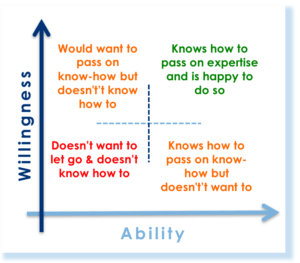 You will notice that people fall into 4 main quadrants when it comes to making that shift. We don’t have the time here to go into more depth but this article will help you understand the 4 approaches.
You will notice that people fall into 4 main quadrants when it comes to making that shift. We don’t have the time here to go into more depth but this article will help you understand the 4 approaches.
The amount of information generated every year in organisations and lost when people leave is beyond belief. The companies which find ways of capturing this knowledge will benefit from what they have already paid for.
Hartmut Wiehle, MD @ Values 4 Change
Organisational learning

Viewing learning as a process brings people into the picture. It is more about conscious mental processes and how we think. Organisational learning is about understanding how people learn best and what best impacts changes in behaviour.
Most assumptions about what learning is, how it occurs and what it should focus on are outdated. People once viewed learning as an intellectual, rational, classroom-based process. This needs to change. The truest learning is ‘context-dependent’ – knowledge gained by weaving a ‘social fabric’ through new experiences and perspectives. Boundaries are essential, not as limits but as markers to focus your learning.
Systems expert Peter Senge defines a learning organisation as a culture where “people continually expand their capacity to create the results they truly desire.”
Ultimately, organisations learn only through their people. Individual learning does not guarantee organisational learning but certainly lays the foundation for it.
Developing a robust organisational learning programme involves many people who plan, develop, organise, implement and evaluate your learning strategies. You need someone in charge, whether an in-house manager, external contractor or team. The elements of an effective learning programme include:
- Content: Organise all your materials and learning items, such as curricula and course materials, assessments, tests, competency models, employee performance and development plans, and employee evaluations.
- Delivery options: Choose instructional methods to suit your organisational needs, budget, goals and learners. Choices include classroom training, seminars, virtual workshops, and so on.
- Technology: Select a way to manage your learning activities. Your goal is to find the “right technologies” and to use them the “in the right way.”
- Administration and marketing: You’ll need to cover many discrete organisational tasks. An administrative set-up and a systematic approach will ensure these are handled correctly and that everything is done properly, on time and on budget.
Design with the digital world in mind
Think of digital solutions which can help you design organisational learning. There are many solutions to choose from including Freshdesk, Bloomfire, or my personal favourite Confluence. These 3 support mobile devices and smartphones to allow people to work from anywhere and use time more efficiently.
Social computing needs to be considered thoroughly. Employees use social networking sites to create, identify content and build relationships. This in turn creates new information and value. Social computing relies on participants to invent, share, rate and consume content, and it improves the more people interact with and build on it. Don’t reinvent the wheel but rather seek to harness what is already there.
After all, a learning organisation requires a learning culture, a pervasive corporate attitude that promotes and supports learning at all levels and in a variety of ways. Lead with a leadership culture that supports a company-wide quest for knowledge.
Knowledge Management

This is about creating or acquiring knowledge to enhance performance and is often associated with IT or those who manage information systems. We go beyond this.
Successful KM can take radically different forms, from Toyota’s production system, which gives workers autonomy and responsibility, to Wikipedia, with its ever-evolving mass online collaboration.
Involve as many people as possible. People – not technological issues – are your greatest challenge when you bring KM to life because you are creating an ongoing shift in your firm’s culture. People need to feel safe to ask questions and share knowledge.
Start with those willing and able to share. Engage with your executives (to lead by example), enlist the help of heads of human resources (to support learning), IT (to support and integrate systems), finance (to recognise the role of knowledge in innovation), and internal communications & marketing (to publicise your initiatives). Promote KM by increasing interaction with customers and seeking out ‘knowledge intermediaries’ within your company.
People are most receptive when they face a problem or an opportunity. Emerging technologies provide access to knowledge at exactly those critical times.
A holistic approach is required to manage this process. The 7S model is a useful tool considering not only the various elements involved but also their interdependencies. Investing into information technology doesn’t help if, for example, your leadership style expects people to read articles on their own time.
Too often, companies allocating resources to persuasive messages for the outside world fail to make similar investments in internal messages. Don’t make that mistake. Brand your initiative and find ways to acknowledge your employees’ involvement. SAS, for example, gave small pins to ToolPool contributors. Publicise your initiative. Share milestones, such as birthdays, and celebrate symbolic success markers, such as the thousandth download.
Use ‘existing channels’ to reach out, but add ‘new channels’ for fresh audiences. Keep your initiative as simple as possible.
A digital KM hub provides your employees with an electronic, single point of entry to knowledge assets, collaborative work environments and expertise from any location, at any time, using any electronic communications device.
Carla O’Dell
So far, we have identified what knowledge exists, how to create a blueprint for learning to flow and what to do to make it practical. When you have started this and have done various re-runs, you will experience a change in your business culture. A company emerges that not only facilitates the learning of its members but where employees become a vital part of learning itself. These organisations are more self-aware, people constantly monitor their environment, respond to changes and by doing so continuously transform themselves and possibly the company itself.
In order to measure that change you can use the Pathfinder, which assesses 35 essential and measurable business drivers. They all change when a company reaches the emerging stage.
Learning Organisation

This domain, with its focus on training, interactive learning and company culture, is often perceived as HR’s remit. This is no longer true because everyone’s life is ultimately about learning and progressing.
Systems thinking, as outlined by Senge in his book the ‘Fifth Discipline’ [1990], helps to highlight the important feedback loops between different parts of a productive system.
Kath Pasteur et al.
Only learning organisations will thrive in tomorrow’s changing marketplace. Becoming a learning organisation requires a new mindset around work and learning. You need to think of learning as a by-product of working, rather than seeing knowledge acquisition as a prerequisite to performing a particular task or job. Today’s learning:
- is based on performance and tied to business objectives;
- focusses on the process of learning how to learn, not just obtaining knowledge; and
- considers learning part of everyone’s job.
Employees usually support what they help create. Empower people. Let go of the outdated belief you have to plan everything through.
The old world is about adapting and methodically integrating knowledge from experts into the organisation, and testing new abilities in safe environments. Future successes might buy in expert knowledge but will use it to quickly adopt and develop new working models. This comes from an intrinsic drive to try out new ‘things’.
As recommended by Russel Sarder, treat learning and development as essential, not discretionary, activities, and fund them accordingly. As a rule of thumb, learning organisations should set aside 2% of their revenues for training, development and learning.
An empowered organisation is one in which individuals have the knowledge, skill, desire and opportunity to personally succeed in a way that leads to collective organisational success.
Shawn Covey
Ability to service customers
Ultimately, the way an organisation deals with its customers, and its ability and willingness to engage, listen and react are paramount.
There are still corporations with dedicated units servicing customers according to guidelines read from a screen. The people in direct contact with customers are not meant to listen and learn (let alone to pass anything on), but to serve.
Successful companies are much closer to the customer, analyse data and trends, identify their most valuable segments and concentrate efforts on customers who are part of a profitable strategic orientation.
Conclusion
Some companies think they are too big to fail. The truth is inflexibility, which increases with size, has a negative effect on your ability to react and adapt. To survive your organisation needs some level of agility.
Organisational skills might well be the area most affected by digitalisation. This is both a challenge and an opportunity.
Start by involving your people and helping them understand why your company needs to go on the digital journey and how it is linked to knowledge management.
Use the many best practices of KM [BASF’s Perspective Campaign, EnBW’s Academy, UniCredit’s UniManagementCentre, Siemens SLE etc.]. Embrace systems thinking by using tools like the 7S to engage with all the relevant players and parts in the business.
Take one step at a time and make everything as measurable and tangible as possible by using assessments like Digitalisation Readiness Check. Make sure each step is part of a larger strategy. Experiment and learn along the way; make everyone feel part of a cohesive, more responsive business.
This is only the first major leap companies will have to do. The next is about opening your business (system) to and starting to connect with the systems around you (e.g. markets, clients, societies). A practical example is how accelerator programmes allow corporates to explore innovation with startups which are so fundamentally different to them. It looks like we are starting to learn that doing business in a more natural way is closer to our human nature than most people might think.
To see how we integrated the 7S into what clients call a “clever and game-changing approach” when assessing business units and teams, please try our Pathfinder Freemium version.
Additionally, watch this short clip to see how SKILLS fits into the bigger picture. If you are interested in finding about more, please feel free to get in touch with me because I am genuinely interested in connecting with people who also want to explore what is coming our way and what do with it.
